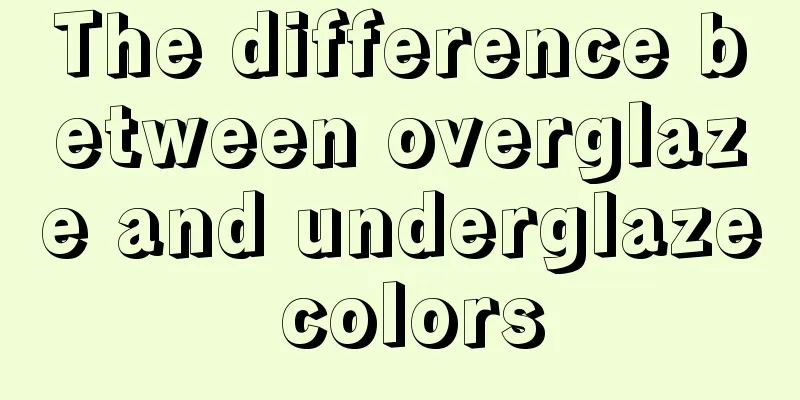The difference between overglaze and underglaze colors

|
Nowadays, many people have ceramic ornaments in their homes, because these ceramic ornaments are embroidered with beautiful patterns, which look very beautiful and artistic. However, everyone thinks that ceramic ornaments are printed during the firing process. In fact, some ornaments need to be hand-painted, and the process is very difficult. Let us take a look at what is the difference between overglaze and underglaze colors? Introduction to overglaze color: a type of ceramic color decoration. Also known as "Lucai". The so-called overglaze color is to first fire white glazed porcelain, or fired into monochrome glazed porcelain, or multi-colored porcelain. After painting on such ceramics, they are put into the kiln and baked at a temperature of 600 to 900 degrees Celsius. Overview: Overglaze painted porcelain has a long history. In the sixth year of Wuping in the Northern Qi Dynasty (575 AD), quite exquisite white and green colored wares were unearthed from Fan Cui's tomb, and red colored decorations can also be seen on many Jin Dynasty blue wares. Truly mature overglaze colored wares famous for their painted patterns first appeared in the Changsha Kiln during the Tang Dynasty. Later, the Cizhou Kiln in the Song Dynasty further developed this craft technology and created many immortal masterpieces. The red and green colors of the Cizhou kiln from the Jin Dynasty to the Yuan Dynasty pioneered the five-color porcelain of the Ming Dynasty. In the Chenghua, Jiajing and Wanli periods in the middle and late Ming Dynasty, the production of five-color porcelain reached an extremely high level. However, the most exquisite and beautiful colored wares are still the five-color and pastel-colored wares from the Kangxi, Yongzheng and Qianlong dynasties of the Qing Dynasty. Among them, whether judging by the exquisite craftsmanship or the painting skills of the works, Yongzheng famille rose ware should be slightly better. Enamel ware was once very famous and sold at sky-high prices, making it a rare treasure. Introduction to underglaze color: A type of porcelain glaze decoration, also known as "kiln color". Underglaze color is a major decorative method for ceramics. Various patterns are painted on the formed and dried blanks (i.e. semi-finished products) with pigments, and then covered with white transparent glaze or other light-colored glaze, and fired in a kiln at high temperature (1200-1400℃) in one go. After firing, the pattern is covered with a layer of transparent glaze underneath, and the surface is bright, soft, smooth and not protruding, appearing crystal clear. Its characteristic is that the color is well preserved and does not fade over time. The blue and white porcelain, underglaze red porcelain, blue and white underglaze red, underglaze tri-color porcelain, underglaze multicolored porcelain, etc. that we usually see are subcategories of underglaze colored porcelain. Underglaze color is a type of color that is applied directly to the porcelain body and then covered with a layer of transparent glaze. After entering the kiln, it is fired at the same time as the porcelain in a high-temperature atmosphere. Its outstanding advantages are that it is not easy to wear, never fades, is lead-free and non-toxic, smooth and flat, and easy to operate. Jingdezhen blue and white porcelain from the Yuan, Ming and Qing dynasties was the most successful production of underglaze color and is one of the representative varieties of Chinese porcelain. Underglaze colors include blue and white, underglaze red, underglaze tri-color, underglaze five-color, underglaze brown, brown-green, etc. |
<<: Increased serum alanine aminotransferase
>>: The difference between ice wine and wine
Recommend
How to prevent dandruff
In life, because everyone has a different lifesty...
Symptoms of nasopharyngeal angiofibroma
Nasopharyngeal angiofibroma is a rare disease but...
Understanding the HPV virus that causes cervical cancer
Cervical cancer is a major health hazard for wome...
Plantar melanoma
Plantar melanoma is a common tumor that appears o...
Two prescriptions for syndrome differentiation and diet therapy for patients with colorectal cancer
Colorectal cancer patients become weak after a se...
How to wash off rust on clothes
Ironware is very common in our lives because iron...
What are the dangers of using a belly belt
Female friends often do things related to weight ...
What are the commonly used folk remedies for treating liver cancer? A complete list of commonly used folk remedies for treating liver cancer
A survey result recently released by the National...
How to quickly reduce edema in the morning
Many people find their faces are swollen when the...
Is grape seed good for whitening?
Grape seeds have high nutritional value, especial...
What are the symptoms of cor pulmonale heart failure
The harm caused by cor pulmonale and heart failur...
Causes of pain in the bend of the knee behind the knee
Although there are many means of transportation n...
Thick yellow tongue coating and bad breath
The symptom of thick yellow tongue coating is rel...
What are the symptoms of corneal damage
I believe that many people often encounter the pr...
Can I eat gentian after removing a mole?
Gentiana can actually help clear away heat very w...









